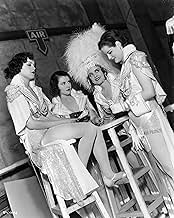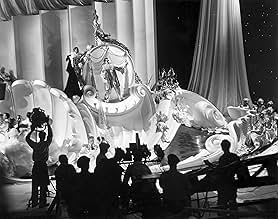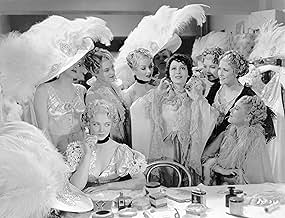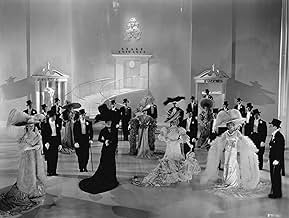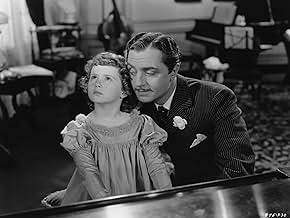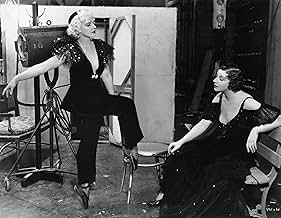Die Höhen und Tiefen von Florenz Ziegfeld jr., der berühmten Produzentin extravaganter Bühnenrevue, werden porträtiert.Die Höhen und Tiefen von Florenz Ziegfeld jr., der berühmten Produzentin extravaganter Bühnenrevue, werden porträtiert.Die Höhen und Tiefen von Florenz Ziegfeld jr., der berühmten Produzentin extravaganter Bühnenrevue, werden porträtiert.
- Regie
- Drehbuch
- Hauptbesetzung
- 3 Oscars gewonnen
- 8 Gewinne & 5 Nominierungen insgesamt
- Fannie Brice
- (as Fannie Brice)
- Dr. Ziegfeld
- (as Joseph Cawthorne)
Empfohlene Bewertungen
Fast-forward to 1936, a couple of years after Ziegfeld's death, and cinema still bears his mark. Musicals (which were still often based around stage performances) were often showcases for a variety of dancing and singing talents, usually building to a spectacular finale. The Great Ziegfeld is more than just a biopic, it is the culmination of this strand in cinema; the first epic musical. Here we see the 30's musical's shimmering sets and full-on dance routines on a scale never before seen on the screen. Robert Z. Leonard directs with his usual sweeping camera moves, often slowly pulling back to reveal the size of the production. But he also lets his camera get deeply involved in the more dramatic scenes.
Apart from the various song-and-dance people involved, the casting here is very much a Hollywood affair. William Powell was then the go-to man for such smart and witty types. He and Myrna Loy were well-known as a screen couple, from The Thin Man pictures amongst others. They both give adequate portrayals, but in truth these two need a smaller, more intimate production to shine in their own right. The performance that best fits the size of The Great Ziegfeld is that of Luise Rainer. Melodramatic, full of presence, she seems always on the verge of breaking down into some farcical display of ham acting, but never quite does so. It's not a realistic performance by any stretch, but it is beautiful in its theatricality.
Ziegfeld's influence would live on in musical cinema for many years after his death. The Great Ziegfeld was just the first in a series of pictures tipping their hat to the producer. Meanwhile, many of the stars made famous by Ziegfeld – Billie Burke, Eddie Cantor, Will Rogers, Ray Bolger – were finding fruitful careers on the silver screen. It was, after all, the way of the future. You see, it wasn't just the depression that finished Ziegfeld. Even if he had lived, cinema would have provided him with too much competition to continue with his follies, especially with the advent of sound. But this is beside the point. If The Great Ziegfeld shows anything, it is that the spirit of showmanship that he championed could live on, if not in one medium then in another.
Powell is, as always, terrific. Oddly he did not receive an Oscar nomination for this film but did get one the same year for MY MAN GODFREY. Luise Rainer won the best actress Oscar for her performance as Anna Held. Myrna Loy plays Billie Burke. The great Fanny Brice appears as herself and just about steals the show until they stupidly and abruptly cut away from her as she starts singing "My Man." She doesn't show up again.
Ray Bolger gets a whole number to himself. And Dennis Morgan fronts the mammoth "A Pretty Girl Is Like a Melody" number (although it's the voice of Allan Jones), which ranks among the great production numbers of the era. The camera slowly pans up a seemingly endless spiral staircase filled with pretty girls as draperies are raised to expose more and more staircase. Then we finally reach the top with Virginia Bruce posed there. It's a giddy and spectacular sequence.
The ballet sequence featuring Harriet Hoctor is rather a bore. I'd rather have seen more of Fanny Brice. Brice is hilarious in the dressing-room with blonde Esther Muir. Powell and Rainer are really excellent in this film. Notable co-stars include Frank Morgan, Joseph Cawthorn, Herman Bing, Marcelle Corday, Nat Pendleton, Grace Hayle, Ernest Cossart, William Demarest, and Reginald Owen.
And while Brice appears as herself the Will Rogers and Eddie Cantor appearances are fakes. Virginia Bruce plays a character based on Lillian Lorraine, and Rosina Lawrence plays Marilyn Miller (here named Sally Manners).
An excellent film in the old style and worth the 3 hours it takes to watch it. Ziegfeld was a great showman and he deserved this fabulous tribute. He died in 1932, having given the world a number of major stars and great shows.
The Great Ziegfeld agreed is overlong with a draggy and at times uneventful first half and half an hour could easily have been trimmed. And more could have done with the relationship between Ziegfeld and Billie Burke which appeared late in the film and didn't feel developed enough, almost like an afterthought.
However, The Great Ziegfeld is very lavishly mounted, with photography that's both beautiful and clever, sumptuous costume design and some of the most handsomely gorgeous sets of any 30s musical. Other pleasures are the marvellous and very well-staged(without being too overblown) songs with A Pretty Girl is Like a Melody being an absolute show-stopper, a script peppered with humour and heart and the mostly poignant story. Standout scenes were Fanny Brice's charming My Man, Ray Bolger's witty dancing to My Follies Girl, Luise Rainer's heart-breaking telephone(justifiably famous) and especially A Pretty Girl is Like a Melody with its clever photography and perhaps one of the best uses of a staircase in a film. The direction is adept and the performances are great, with William Powell suave personified and especially Luise Rainer who is the epitome of charm and grace, capable of a good range of emotions as seen in the telephone scene. Fanny Brice, Frank Morgan, Ray Bolger are all memorable, while Myrna Loy is underused she's hardly wasted either.
Overall, a well-made, entertaining and very good film and well worth the look. 8/10 Bethany Cox
Structurally, the narrative takes a chronological approach. However, except for the film's starting year of 1893 and the ending soon after the 1929 stock market crash, no dates are given, a shortsighted flaw in the screenplay. But during this roughly forty-year period we see Ziggy's ambition unfurl into a successful career of producing some of the most extravagant musical shows in history. And throughout, the theme remains the same: to "glorify the American girl", that is to say to glorify the early twentieth century stereotyped image of the American girl.
Despite his success as a showman, Ziggy was constantly plagued with financial problems, and embroiled in relations with women, the two most important being: the humorously indecisive Anna Held, and the lovely Billie Burke.
More interesting to me than the biography is the lavish, grandiose production numbers. In the most grandiose of all, Dennis Morgan sings "A Pretty Girl Is Like A Melody", as the camera ascends a slowly revolving spiral staircase adorned with "Ziegfeld girls" in outlandish costumes. The set, resembling a wedding cake, is about as tall as it is wide, with the stage curtain rising to what seems like stratospheric heights.
The film's strengths are its humorous script, the dazzling sets, the glamorous costumes, the music, a cameo appearance by Fanny Brice, and a great tap dance routine by Ray Bolger. My main complaint is the film's length. Also, I find it curious that this big budget beast with its theme of wealth and beauty came out right in the middle of the Great Depression. MGM must have been on a colossal ego trip.
Overall, "The Great Ziegfeld" is fun, and definitely worth watching, especially as a time capsule to an entertainment era that is gone forever.
Oscars Best Picture Winners, Ranked
Oscars Best Picture Winners, Ranked
Wusstest du schon
- WissenswertesA.A. Trimble, who portrays Will Rogers in the film, was a Cleveland map salesman who frequently impersonated Rogers at Rotarian lunches.
- PatzerIn the "Rhapsody in Blue" portion of the mammoth "Pretty Girl" number, one of the silver-fringe-and-antlers quartet of dancers gets visibly disoriented when her group does its final moves. She's the second one from the left, and her movements are completely out of sync with the other three until, with a thump, she sits down on the stairs. Since the incredibly complex number was shot in very long takes, the error was allowed to remain in the film.
- Zitate
Florenz Ziegfeld Jr.: [after catching Ray Bolger doing a little softshoe backstage] Buddy, you're better with your feet than you are with your broom.
Ray Bolger: Mr. Ziegfeld, you think so? Gee, I wish you'd give me a chance. I've got talent, and I'd like to get away from shifting scenery and moving props.
Florenz Ziegfeld Jr.: How long have you been a property boy?
Ray Bolger: Five years, but my heart hasn't been in it.
Florenz Ziegfeld Jr.: You've been working a long time without your heart, buddy.
- Crazy CreditsThe opening credits display the title of the film and the names of the stars in marquee lights, as they would be on Broadway.
- Alternative VersionenThere is an Italian edition of this film, as Bonus Extra, on DVD "FOLLIE DI ZIEGFELD", re-edited with the contribution of film historian Riccardo Cusin. This version is also available for streaming on some platforms.
- VerbindungenEdited into Mädchen im Rampenlicht (1941)
- SoundtracksHarriet Hoctor Ballet
(1936) (uncredited)
(also called "A Circus Must Be Different in a Ziegfield Show")
Music by Con Conrad
Lyrics by Herb Magidson
Sung and danced by male and female choruses
Danced by Harriet Hoctor
Top-Auswahl
- How long is The Great Ziegfeld?Powered by Alexa
Details
- Erscheinungsdatum
- Herkunftsland
- Sprache
- Auch bekannt als
- El gran Ziegfeld
- Drehorte
- Produktionsfirma
- Weitere beteiligte Unternehmen bei IMDbPro anzeigen
- Laufzeit1 Stunde 50 Minuten
- Farbe
- Seitenverhältnis
- 1.37 : 1
Zu dieser Seite beitragen



